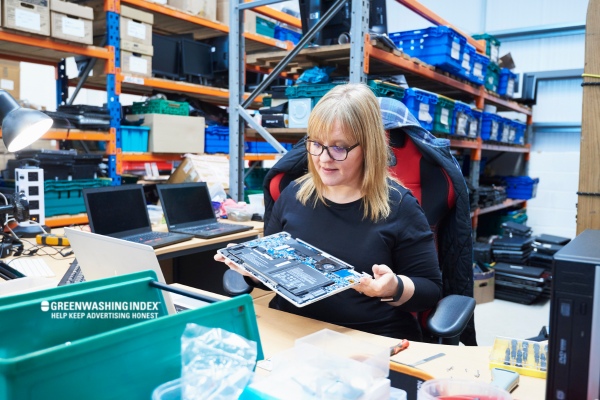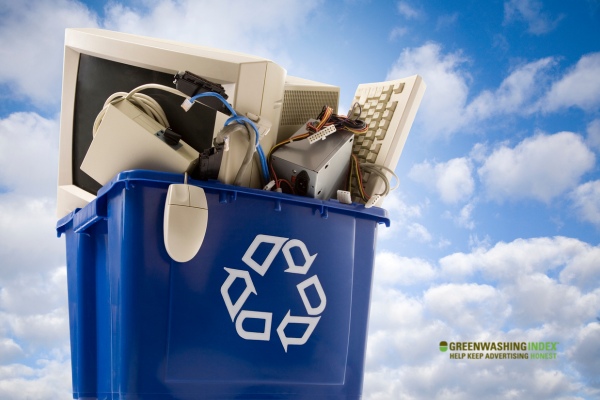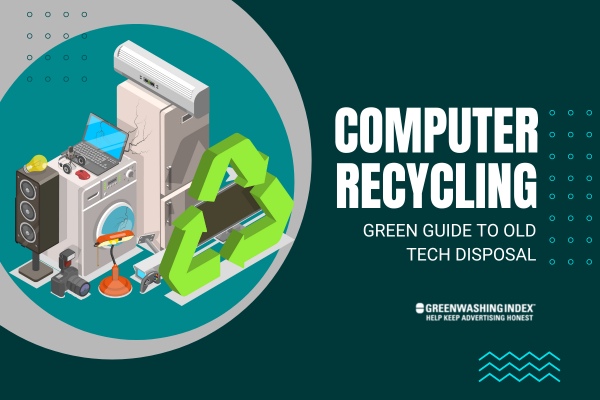Have you ever wondered what happens to old computers when they’re no longer useful? In our rapidly advancing digital age, tech gadgets become obsolete faster than we can keep up. That’s where computer recycling comes in. It’s not just about getting rid of your old machine; it’s about doing it the right way—for the planet and for ourselves.
When we talk about computer recycling, what we are really tackling is a kind of rescue mission for valuable materials and preventing harm to our environment. Responsible recycling means ensuring that your old computer doesn’t end up in a landfill contributing to electronic waste—instead, it gets a chance at a new life, or its parts can be reused and recycled responsibly.
What You’ll Discover Here
- Easy steps for eco-friendly computer disposal
- Protect personal data during computer recycling
- Find local centers for responsible electronics disposal
- Help the Earth with sustainable computing practices
- The do’s and don’ts of green technology practices
Understanding the Basics of Computer Recycling
Computer recycling is a process where old computers that are no longer needed are collected and treated in a way that is safe for our environment. When I speak of computer recycling, it’s not just about taking apart the computer and throwing away the pieces. It’s about taking each part of the old computer and finding a new use for it or breaking it down in a way that doesn’t harm our world.

Why Is Computer Recycling Important and What Does It Mean?
Let me explain why this is so important. Computers have stuff inside them that can be really bad for our earth if we just throw them away like normal trash. They have heavy metals and chemicals – things like lead, mercury, and more – which can get into our land, water, and air if they’re not handled right. So, when I talk about computer recycling, I’m thinking about how to stop these bad substances from causing damage.
But there’s more to it than just keeping bad stuff out of nature. Our world has only so many resources – like metals we use to make new computers – so reusing these materials means we don’t run out as quickly. When an old computer gets recycled properly, lots of parts from it can be used again to make new products or fix other machines.
Also, disposing of our electronics responsibly shows respect for the folks who will come after us – kids who deserve to grow up on a healthy planet.
Practicing environment-friendly methods in handling outdated technology through responsible electronics disposal or green technology practices makes sense not just morally but logically too because once harmful materials are safely removed during the e-waste recycling process, there’s less stuff taking up space at dump sites, which often get piled up higher than mountains!
This way, through electronic waste management, we’re not only preserving natural resources but also reducing pollution caused by manufacturing brand-new parts.
Just imagine every time I choose to recycle my old computer instead of chucking it in the trash; I’m making sure harmful substances aren’t left lying around while also giving valuable parts another chance at life! That’s why knowing about sustainable computing isn’t just good for geeks; it’s important for everyone who cares about keeping our planet clean for generations yet unborn.
So remember, throwing away an old clunky machine might seem easy, but think twice because, with proper e-waste recycling, you’re helping keep Mother Earth green – quite literally saving her from heaps of needless clutter!
The Process of Computer Recycling
Recycling a computer is a good way to take care of our planet. When I finish using my old computer, I make sure to recycle it right. Here’s how you can do that too!
Step-by-Step Guide for Properly Recycling Your Old Computer
Step 1: Back Up Your Data
Before doing anything else, save your important stuff—photos, documents, and other files. You can put these on an external hard drive or in the cloud.
Step 2: Wipe Your Hard Drive Clean
Next, you need to erase all the data on your computer. This stops others from seeing your personal information. Use software designed to thoroughly clean your hard drive.
Step 3: Unplug Everything from Your Computer
Take out all cables, USB drives, and other things plugged into your computer.
Step 4: Decide if It’s Recyclable or Donatable
Look at your old computer closely. If it still works fine, maybe someone else could use it instead of throwing it away.
Step 5: Find a Place That Takes Old Computers
Not every place accepts electronic waste for recycling. Look online or call around to find a spot near you that does.
Step 6: Learn About Their Rules
Some places have special rules about how they take computers for recycling. Make sure you know these before dropping off yours.
Step 7: Take Out Reusable Parts (Only If You Know How)
If you understand computers well enough, you might be able to take parts out that still work fine and use them in other machines.
Lastly,
Step 8: Hand Over Your Old Computer Responsibly
Bring your old computer to the place you found and leave it there, knowing you’re doing good for our planet.
By following these steps carefully, I ensure my old computers are taken care of in an environmentally friendly way!
Preparing Your Old System for Secure and Eco-Friendly Disposal
When it’s time to say goodbye to my old computer, I make sure to do it the right way. Computer recycling is not just about getting rid of the hardware; there’s a process I follow to ensure that my personal information stays safe and that the computer disposal is friendly to the environment.

Conducting a Comprehensive Data Backup before Initiating
Before I think about recycling my computer, backing up my data is crucial. Here’s how I do it:
- Identify Important Files: First, I go through the files on the computer and pick out what needs saving – documents, photos, music – anything important.
- Choose a Backup Location: Next up, I decide where these files will go. It might be an external hard drive or cloud storage—any place that’s secure and has enough space.
- Utilize Backup Software: Sometimes, using dedicated software helps speed along the process. Whether it’s a built-in tool like Windows Backup Mac Time Machine or third-party software doesn’t matter as long as it gets everything copied securely.
- Verify Your Backup: After running the backup, checking to confirm everything has been copied correctly can save me headaches later on.
- Keep Multiple Copies: For extra security, making more than one copy of my data in different places means even if one fails, I’m covered.
Following these steps ensures all personal data is off my old machine before moving on to recycling – safeguarding against identity theft or data loss.
Critical Steps for Safe Deauthorization and Software Deactivation
Once all my data is backed up safely elsewhere:
- Deauthorize Accounts: Many programs like iTunes or Adobe Creative Suite need deauthorizing before disposing of your device.
- Uninstall Programs: Removing installed programs reduces risks associated with leaving behind license information or personal preferences connected to those applications.
- Clear Browser Information: Don’t forget web browsers! They store passwords and other sensitive info that should be wiped clean through each browser’s settings menu.
- Factory Reset / Hard Drive Wipe: The safest step is doing a factory reset, which wipes everything clear again (check your device manufacturer’s instructions), but sometimes clicking ‘reset’ isn’t enough—software exists for wiping hard drives completely clean, which can be worth using for peace of mind.
By carefully backing up all valuable data and methodically ensuring no trace of licenses or sensitive info remains before recycling my computer, I responsibly protect myself while also adhering to green technology practices that benefit our environment.
FAQs
How can you ensure total data removal before computer recycling?
To make sure all your data is gone before recycling a computer, use software made to wipe the hard drive clean. You could also take out the hard drive and destroy it yourself.
Is it possible to retrieve files from a dead computer?
Yes, sometimes files can be saved from a dead computer by connecting its hard drive to another working one. However, if it’s badly damaged, this might not work.
Conclusion
The gravity of computer recycling cannot be stressed enough. It is a key part of sustainable computing and efficient electronic waste management. By understanding and adopting green technology practices, we play a crucial role in reducing e-waste that could otherwise harm our environment.
As we’ve learned, proper disposal is not just about tossing an old device; it’s about taking collective responsibility to ensure our digital convenience does not become an ecological calamity. Let’s commit to environmentally friendly disposal always.



